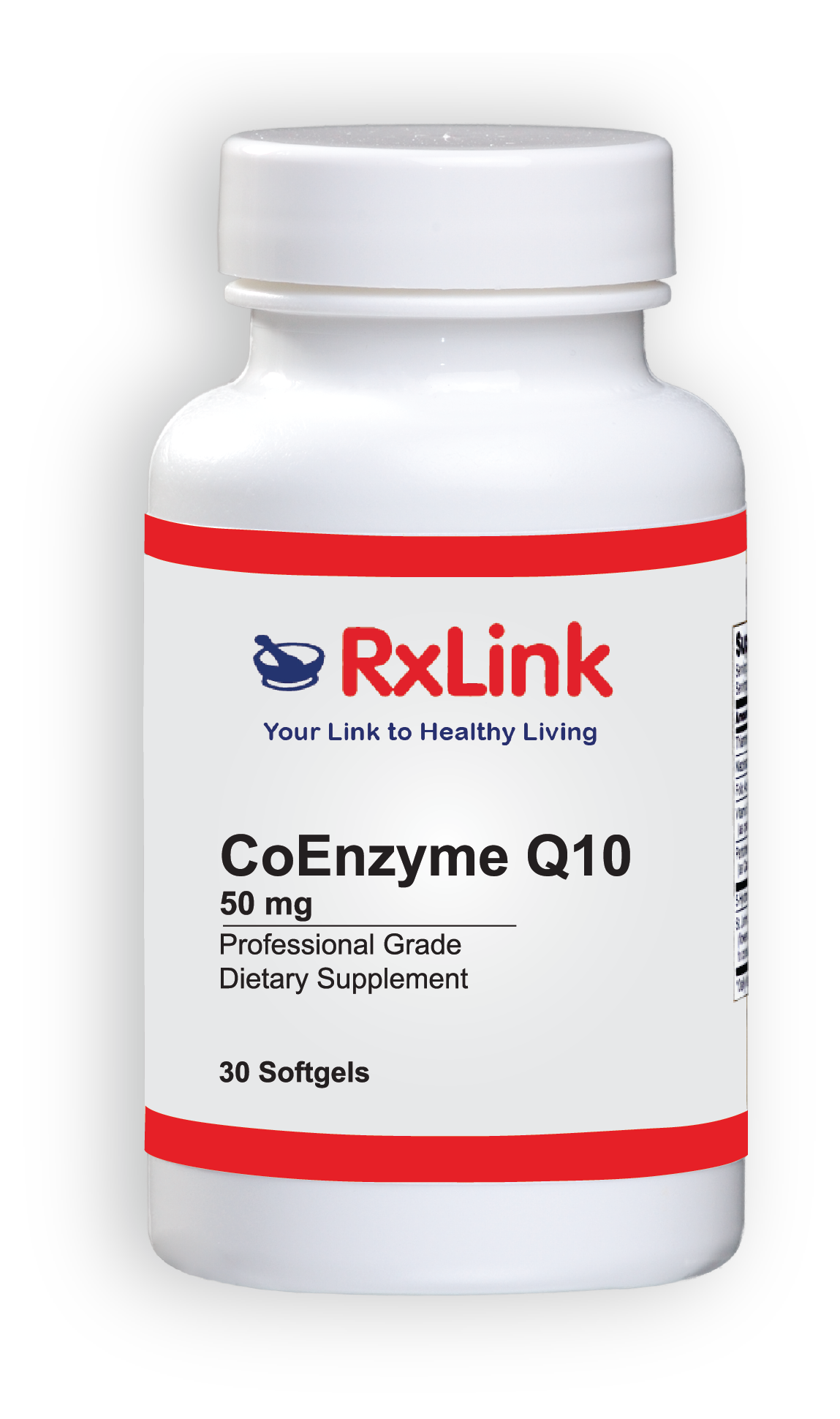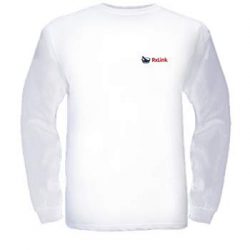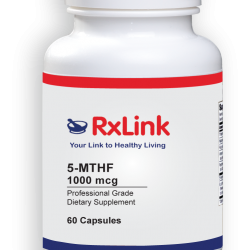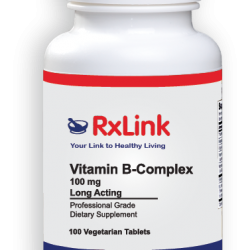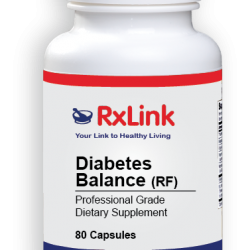Description
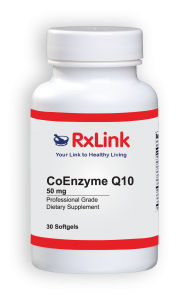
DESCRIPTION RxLink Co-Enzyme Q10 softgels contain pure co-enzyme Q10 (ubiquinone). Co-enzyme Q10 is solubilized in a base of rice bran oil and vitamin E to enhance absorption of co-enzyme Q10. FUNCTIONS Co-Enzyme Q10 (ubiquinone) is an important rate limiting cofactor in the mitochondrial electron transport chain, the biochemical pathway in cellular respiration from which adenosine triphosphate (ATP), the form of energy used by the body, is derived. Since cellular activities are dependent upon energy, co-enzyme Q10 is crucial for the efficient functioning of nearly every cell. In addition to its well-established function as a component of the mitochondrial electron transport chain, co-enzyme Q10 has in recent years acquired increasing attention regarding its antioxidant properties. RxLink Co-Enzyme Q10 occurs in all cellular membranes as well as in blood serum and in serum lipoproteins. As a lipid-soluble antioxidant, coenzyme Q10 efficiently protects membrane phospholipids and serum low-density lipoproteins from lipid peroxidation. And, as recent data indicate, it also protects mitochondrial membrane proteins and DNA from free radical induced oxidative damage.
These effects of co-enzyme Q10 are independent of those of other antioxidants, such as vitamin E; although coenzyme Q10 can also extend the functions of vitamin E by regenerating it from its oxidized form. Tissue co-enzyme Q10 levels are regulated through the mevalonate pathway, increasing with various forms of oxidative stress, and decreasing during aging. Related to its antioxidant properties, co-enzyme Q10 is important for normal immune function. This has been shown in a number of experimental and clinical studies.
Healthy people have the ability to synthesize adequate amounts of co-enzyme Q10. According to Dr. Karl Folkers and other researchers, humans can synthesize co-enzyme Q10 from the amino acids tyrosine or phenylalanine and mevalonic acid, all of which are abundant in the body. However, the synthesis is a complex process involving 15 separate steps which require many enzymes, nutritional mineral cofactors, and vitamin coenzymes.
As a result, the biosynthesis of co-enzyme Q10 in the human body requires a good diet – one that is high in vitamins, minerals, and other nutrient factors. Yet, it has been shown by NHANES I and II studies that many Americans do not consume an adequate diet. Rather, for many, dietary intake of water soluble vitamins, vitamin A, and some minerals and trace elements is insufficient. Many of these nutrients are essential for the biosynthesis of co-enzyme Q10. Thus, it is not surprising that the nutritional status of co-enzyme Q10 tends to decline with advancing age. In addition, it has been shown that in disease states, nutrients from food sources may not be readily absorbed or bioavailable. According to Folkers and other experts, co-enzyme Q10 should be considered an essential nutrient, as it is well established that coenzyme Q10 is essential for the health of every cell in the human body. INDICATIONSRxLink Co-Enzyme Q10 softgels may be a useful dietary supplement for those who wish to support their body’s own production of co-enzyme Q10.
FORMULA (RxLink10039) 1 Softgel Capsule Contains:
Vitamin E ……………………………………………..10 IU (as d-alpha tocopherol)
Coenzyme Q 10 ………………………………………….50 mg
Other Ingredients: Capsules (gelatin, glycerin, water), rice bran oil, lecithin, beeswax, zinc oxide and annatto (color). Contains soy. Manufactured on equipment that processes peanuts. May contain traces of peanuts.
This product contains NO sugar, salt, dairy, yeast, wheat, gluten, corn, preservatives, artificial colors, or flavors. SUGGESTED USE As a dietary supplement, adults take 1 softgel 1-3 times daily with meals, or as directed by a healthcare professional. SIDE EFFECTS No adverse effects have been reported. STORAGE Store in a cool, dry place, away from direct light. Keep out of reach of children.
References on following page
RxLink Co-Enzyme Q10 50 mg Softgels with Vitamin E
RxLink Pharmacy P.O.Box 996 Appleton, WI 54912 www.RxLinkPHarmacy.net
REFERENCES Alleva R, Tomasetti M, Battino M, Curatola G, Littarru GP, Folkers K. The roles of coenzyme Q10 and vitamin E on the peroxidation of human low density lipoprotein subfractions. Proc Natl Acad Sci USA 1995;92:9388-9391.Amimoto T, Matsura T, Koyama S-Y, Nakanishi T, Yamada K, Kajiyama G. Acetaminophen-induced hepatic injury in mice: The role of lipid peroxidation and effects of pretreatment with coenzyme Q10 and a-tocopherol. Free Radic Biol Med 1995;19:169-176. Beyer RE. The role of ascorbate in antioxidant protection of biomembranes: Interaction with vitamin E and coenzyme Q. J Bioenerg Biomembr 1994;26:349-358. Bliznakov EG. Coenzyme Q, the immune system and aging. In: Biochemical and Clinical Aspects of Coenzyme Q10, Vol 3, Folkers K and Yamamura Y Eds., Elsevier Science Publishers, 1981, pp.331-326. Chen H, Tappel AL. Vitamin E, selenium, trolox C, ascorbic acid palmitate, acetylcysteine, coenzyme Q, b-carotene, canthaxanthin, and (+)-catechin protect against oxidative damage to kidney, heart, lung and spleen. Free Radic Res 1995;22:177-186. Ernster L, Dallner G. Biochemical, physiological and medical aspects of ubiquinone function. Biochim Biophys Acta Mol Basis Dis 1995;1271:195204. Folkers K, Littarru GP, Yamagami Y, Eds. Biochemical and Clinical Aspects of Coenzyme Q10, Vol 6, Elsevier Science Publishers, 1991. Folkers K, Morita M, McRee J, Jr. The activities of coenzyme Q10 and vitamin B6 for immune responses. Biochem Biophys Res Commun 1993;193:88-92. Folkers K, Simonsen R. Two successful double-blind trials with coenzyme Q10 (vitamin Q10) on muscular dystrophies and neurogenic atrophies. Biochim Biophys Acta Mol Basis Dis 1995;1271:281-286. Greenberg S, Frishman WH: Coenzyme Q10: a new drug for cardiovascular disease. J Clin Pharm 1990;30:596-608. Kamikawa T, Kobayashi A. Effects of coenzyme Q10 on exercise tolerance in chronic stable angina pectoris. Am J Cardiol 1985;56:247-251. Kontush A, Hübner C, Finckh B, Kohlschütter A, Beisiegel U. Antioxidative activity of ubiquinol-10 at physiologic concentrations in human low density lipoprotein. Biochim Biophys Acta Lipids Lipid Metab 1995;1258:177-187. Langsjoen PH et al. Long-term safety and efficacy of coenzyme Q10 therapy for idiopathic dilated cardiomyopathy. Am J Cardiol 1990;65:521-523. Lockwood K, Moesgaard S, Yamamoto T, Folkers K. Progress on therapy of breast cancer with vitamin Q10 and the regression of metastases. Biochem Biophys Res Commun 1995;212:172-177. Maurer I et al. Coenzyme Q10 and respiratory chain enzyme activities in hypertrophied human left ventricles with aortic stenosis. Am J Cardiol 1990;66:504-505. Morita K, Ihnken K, Buckberg GD, Young HH. Studies of hypoxemic/ reoxygenation injury: Without aortic clamping. VII. Counteraction of oxidant damage by exogenous antioxidants: Coenzyme Q10. J Thorac Cardiovasc Surg 1995;110:1221-1227. Mortensen SA et al. Deficiency of coenzyme Q10 in myocardial failure. Drugs Exp Clin Res 1985;10:497-502. Nakamura R et al. Study of CoQ10 enzymes in gingiva from patients with periodontal disease and evidence for a deficiency of coenzyme Q10. Prc Natl Acad Sci 1974;71:4156-4160. Stoyanovsky DA, Osipov AN, Quinn PJ, Kagan VE. Ubiquinone dependent recycling of vitamin E radicals by superoxide. Arch Biochem Biophys 1995;323:343-351..
These statements have not been evaluated by the Food and Drug Administration. This product is not intended to diagnose, treat, cure, or prevent any disease. RxLink LLC
Manufactured for RxLink

